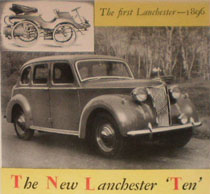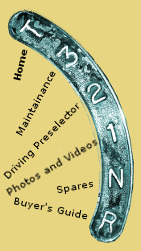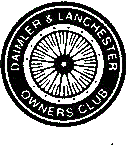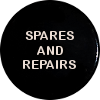

| Buyer's Guide Part 1 |
| Well, mad impetuous fool
that you are, you have decided to buy an old car
and are considering a Lanchester L. D. 10. Generally some rules always apply to buying any car but especially to something as old as an L. D. 10. Firstly, do your homework and get to know the cars as well as you can by research. Secondly, don't buy the first one you see (unless it is an auction bargain - BUT please be careful). Thirdly, take along a friend who really knows about old cars. Because even if you are knowledgeable yourself, two sets of eyes are better than one (and yours will probably be wearing rose tinted glasses). Buy the best one you can. Seriously, you will never get the money back you invest in restoration - ever. Don't be afraid to walk away from a car that is not up to the standard you require for the money the over optimistic seller is hoping to get. Fourthly, never trust an MOT certificate. Always check everything on the car thoroughly. |
| So as an old car buyer, your
number one enemy is rust (it can also affect the
car) :) .But in the case of a coach built
Lanchester, you also need to worry about wet
rot, dry rot, woodworm, mushrooms, moths, mice
and pretty much any other form of wildlife you
can think of. Rust. Well, with the L. D. 10, you are fortunate because the chassis is exceedingly sturdy, doesn't have box sections and is therefore easy to inspect and not too hard to repair. The body of the earlier Briggs built cars has steel bodywork, but the later barker ones have an aluminium body apart from the front wings and sills and small steel pressings scattered here and there around the body, such as under the edge of the boot lid. All cars have an ash frame and various plywood panels. Body chassis repairs are a huge undertaking and cost a fortune so unless you are very rich or crazy or bored (or all three) avoid cars with serious rust issues. Woodworm. Potentially this is harder to spot than rust as it can be hidden away under the panels where you cant see it. Check any wood you can for crumbling, flight holes and frass (wood dust) round or beneath holes. If woodworm has got into the car it will be hard to control without resorting to dismantling a lot of the car so it can be sprayed with chemicals. It will also have weakened the structure and can reduce wood to dust so beware! Rot. Here there is some good news, because assuming that it hasn't progressed it can be stopped in it's tracks simply by keeping the car dry. But the same warning as for woodworm applies, wood will have been weakened and hidden areas could be badly damaged. Moth damage will be to upholstery and manifests as holes, silk cocoons, tiny grubs and adult moths. A hand scrubbing brush or a toothbrush and a hoover can work wonders at getting rid of the little horrors. But bear in mind that the grubs tend to eat through the base of carpet fibres so a carpet may shed quite a lot as you clean it. |
| So that's the basics over
with. Because mechanical repairs may be tough
but are a doddle compared to fixing rotten
bodywork. For more detail on what to look out for please read my Buyer's Guide Part 2. |

Click on this logo to go to the
Official L. D. 10 Club Website
 |
 |
 |
 |
 |
 |
“I am an amateur
‘owner
enthusiast’
and have
produced
this
site for
my own
and your
entertainment.
So
please
don’t
expect
100%
accuracy
and seek
professional
advice
before
carrying
out any
work to
your
car. I
think ‘Lanchester’
is
currently
a
registered
trademark
of Tata
Motors.”
Website
produced
using
SharePoint 2007 ©Microsoft, HTML The Missing
Manual and Gimp image editor. Photographs,
videos and site design © Catherine Jones 2015.